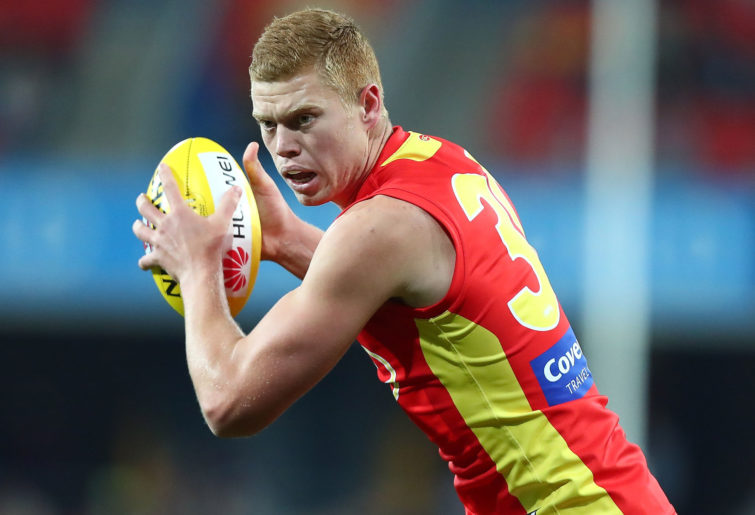The Gold Coast Suns are on the right track.
Sure, a one-point loss to St Kilda, a team who many have tipped to finish just a few places above the Suns this season, isn’t the most obvious indicator, but it was the first game of the revival of a football club that will reach the top in the near future.
The off-season created a headache for Stuart Dew, that hasn’t been experienced by a coach in AFL history, due to the loss of his two best players Steven May and Tom Lynch, who also happened to be the side’s two captains and bookends after a four-win season should’ve spelt disaster.

Peter Wright of the Suns celebrates a goal with teammate Tom Lynch. (Photo by Chris Hyde/Getty Images)
Add the departure of former high draft picks Kade Kolodjashnij and Jack Scrimshaw, along with Aaron Hall, and it had football fans and media personalities calling for the club to fold or be relocated to Tasmania.
This could be a blessing in disguise. The off-season fire sale ensured Dew has rid the list of players who don’t want to be there and can begin to implement the structure and culture he believes in.
Dew would know what a successful culture looks like, having starred in premierships for Port Adelaide and Hawthorn, before undergoing a comprehensive coaching apprenticeship under John Longmire at the Sydney Swans.
The development of that culture will help foster and retain the likes of Jack Lukosius, Izak Rankine and Ben King, who are among the most talented youngsters to enter the AFL in the last decade.
While the go-home factor is always a potential threat, the Gold Coast isn’t exactly an undesirable place to live. The lack of a winning culture is undoubtedly the largest contributor to the departures in recent years.
In the meantime, the Suns have assembled a team of youngsters interspersed with fringe players recruited from other clubs. Anthony Miles, Jordan Murdoch, Corey Ellis, Jack Hombsch and George Horlin-Smith all crossed over to the Gold Coast in the off-season.
The mature recruits, Miles and Sam Collins, dominated the VFL in 2018, and the Suns will be hoping both players can translate the form to AFL.
The fringe recruitment strategy isn’t a Gold Coast innovation. Melbourne and Brisbane both used it previously.
In the dark-days of 2013, the club recruited David Rodan, Cam Pedersen and Shannon Byrnes, while Daniel Cross, Bernie Vince and Heritier Lumumba joined in later seasons.
These players, while never expected to be superstars, helped raise the standard of the list immediately. They had also played in successful sides at one stage of their career, passing on that experience of a winning culture to the younger players who would inevitably push them out of the starting line-up.
Six seasons on from when Melbourne were branded ‘worse than Fitzroy’, the club is one of the favourites for the Premiership, with the likes of Max Gawn, Christian Salem and Jack Viney having survived the tough years in order to thrive in the latter part of the decade.
Things change quickly in football.
Just three seasons ago, the Brisbane Lions were a basket case with the infamous go-home five leaving the club devoid of high-end young talent.
The introduction of Chris Fagan has completely turned the Brisbane Lions around. James Aish, Josh Schache and Sam Mayes were granted their wish of leaving the club, and now there is a feeling among the football community that the Lions are only a few seasons away from making a serious impact in the finals.
The truth is, this Suns list is no worse than Melbourne in 2013 or Brisbane in 2014. If Dew can harness the potential of Peter Wright, Ben Ainsworth, Jack Bowes, Jack Martin, Callum Ah Chee, Will Brodie, and Lachie Weller, the future is bright.

Peter Wright of the Suns takes a mark (Photo by Chris Hyde/Getty Images)
Add the recent draft acquisitions and the consistency of Jarrod Witts, David Swallow, Brayden Fiorini, and Touk Miller, and the Suns are beginning to put together a serious squad.
The entire saga surrounding the Suns extends beyond the on-field performances. Year after year there are calls for the AFL to wind up their northern ‘experiment’ and award a team to the apple isle.
The club continues to bleed money, with the AFL chipping in over $25 million extra to it over the past two seasons, and last year averaged only 13,547 fans to their home matches at Metricon Stadium.
Out of context, this sounds horrific, however, it’s in the AFL’s best interests to keep investing in this club.
The Gold Coast is synonymous for its failed sporting franchises and its lacklustre sporting culture, despite the successful hosting of the 2018 Commonwealth Games. In the last decade, the city has lost its NBL and A-League licenses.
However, in what one would imagine is rugby league stronghold, the Suns averaged a larger crowd than the NRL’s Gold Coast Titans and have more members.
The footballing public must realise Rome wasn’t built in a day.
The Sydney Swans hit rock bottom ten years into their own northern experiment. Today the club has over 50,000 members. Those kids, who first watched the Swans in Sydney, have had children of their own, and combined with a sustained period of success, the club has become a powerhouse.
In a considerably smaller market, the Suns won’t ever reach the level they have. But the AFL knows what they are doing.
Junior participation rates on the Coast continue to go up year after year. In 20 years, there’s every chance the Suns could be bigger than most Melbourne clubs, as the kids that are taking up the sport today introduce their children to Australia’s game.
You don’t have to agree with the AFL on everything, but they’re right on this occasion. The Gold Coast Suns, both on and off the field, are on the right track.






























































































